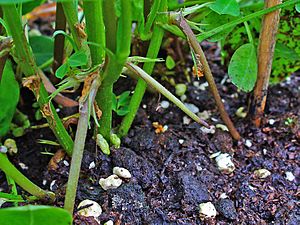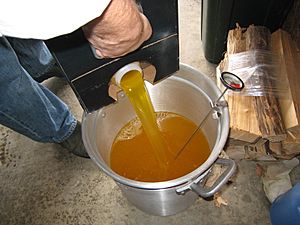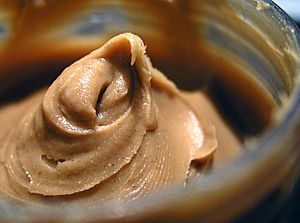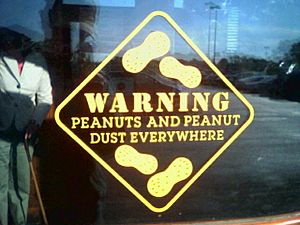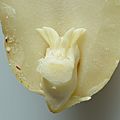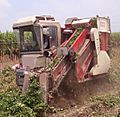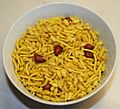Peanut facts for kids
Quick facts for kids Peanut |
|
|---|---|
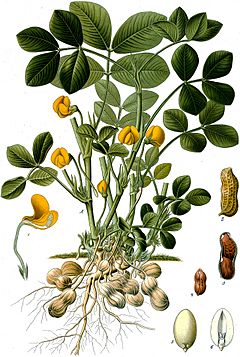 |
|
| Peanut (Arachis hypogea) | |
| Scientific classification | |
| Kingdom: | |
| Division: | |
| Class: | |
| Order: | |
| Family: | |
| Subfamily: | |
| Tribe: |
Dalbergieae
|
| Genus: | |
| Species: |
A. hypogaea
|
| Binomial name | |
| Arachis hypogaea |
|
A peanut is a special plant that grows its yummy seeds underground! It's part of the legume family, just like peas and beans. Peanuts originally came from South America, Central America, and Mexico.
These plants are annuals, meaning they grow and produce seeds within one year. They usually reach about 30 to 50 centimeters (1 to 1.5 feet) tall.
Contents
Parts of a Peanut
A peanut has several parts, even though it looks simple:
- Shell - This is the tough outer layer that protects the peanut. It's usually covered in dirt because peanuts grow underground!
- Cotyledons (two) - These are the two main, edible halves of the peanut that you eat.
- Seed coat - This is the thin, brownish, paper-like skin that covers each edible peanut half.
- Radicle - This is the tiny, early root that would grow if you planted the peanut. It's at the bottom of the cotyledon.
- Plumule - This is the tiny, early shoot that would grow into the plant's stem and leaves. It comes out from the top of the radicle.
Growing Peanuts
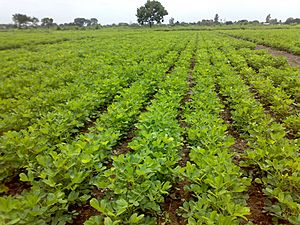
Peanuts like to grow in light, sandy soil that drains well. They are amazing plants because they can create their own nitrogen in the soil. This means they don't need much nitrogen fertilizer. In fact, growing peanuts can even make the soil better for other plants! Farmers often grow peanuts in crop rotation with other crops. This helps keep the soil healthy and reduces plant diseases and pests.
For peanuts to grow well, they need warm weather for their whole growing season. They can grow with a little water, but they produce the most peanuts with more water. Depending on the type of peanut and where it's grown, it takes about 90 to 150 days from planting until harvest.
Peanut plants keep making flowers even when their pods are growing underground. This means that when it's time to harvest, some peanuts are still young. Farmers have to decide the best time to harvest to get the most mature peanuts. If they harvest too early, many peanuts won't be ready. If they wait too long, the peanuts might break off the plant and stay in the soil.
Harvesting Peanuts
When it's time to harvest, the whole peanut plant, including most of its roots, is pulled out of the ground. Modern machines cut the main root just below the peanuts. Then, the machine lifts the plant, shakes off the dirt, and flips the plant upside down. This leaves the peanuts out of the soil to dry slowly for a few days. In the past, people did all this by hand.
After the peanuts dry enough, they are "threshed." This means the peanut pods are separated from the rest of the plant. It's super important that peanuts are dried properly and stored in dry places. If they are too wet, or stored badly, a type of mold called Aspergillus flavus can grow on them. Some of these molds can make harmful substances called aflatoxins.
Peanut Types in the United States
There are many different types of peanuts grown around the world. In the United States, the main types are Spanish, Runner, Virginia, and Valencia. These types are grown in different regions of the country.
Each type of peanut has its own special qualities, like flavor, how much oil it has, its size, shape, and how well it resists diseases. The big peanuts you buy in the shell are usually Virginia types. Spanish peanuts are often used for candy, salted nuts, and peanut butter.
Peanut Production Around the World
| Peanut Production, 2016 (millions of tonnes) |
|
|---|---|
| Country | Production |
|
|
|
|
|
|
|
|
|
|
|
|
|
|
|
|
|
|
|
|
|
In 2016, the world produced about 44 million tonnes of peanuts. China grew the most, making up 38% of all peanuts. India was second, growing 16%. Other big peanut-producing countries include Nigeria, the United States, and Sudan.
In the United States, Georgia grows the most peanuts. About half of all peanuts in the U.S. come from an area around Dothan, Alabama. Dothan even has a special event called the National Peanut Festival every fall to celebrate the peanut harvest!
Peanuts as Food
Peanuts are a favorite food for many people. They can be eaten as a snack, or used in candies, cookies, pies, and other baked goods. About half of the peanuts grown in the United States are used to make peanut butter. However, around the world, most peanuts are grown to make peanut oil. Farmers in Africa and Asia grow about 90% of the world's peanuts.
Peanuts have been grown in South America for a very long time. Today, most peanuts are eaten roasted and salted. Peanut butter, peanut brittle, and candy bars are also very popular. There are two main kinds of peanut butter: chunky and creamy.
Peanut Oil
Peanut oil is often used for cooking. It has a mild flavor and can be heated to high temperatures without burning. It's considered a healthy oil because it has a lot of monounsaturated fats.
Peanut Butter
Peanut butter is a creamy or chunky spread made from ground, roasted peanuts. It often has other ingredients like salt or sweeteners to make it taste even better. People love to spread peanut butter on bread, toast, or crackers. It's also a key ingredient in many sweets, like peanut butter and jelly sandwiches or granola bars. The United States is a big exporter of peanut butter.
Other Peanut Foods
- Peanut flour is a special flour made from peanuts. It's a good option for people who can't eat gluten.
- Boiled peanuts are a popular snack in the southern United States, India, China, and West Africa. In the U.S. South, they are often boiled in salty water and sold by street vendors.
- Dry-roasted peanuts can be roasted at home in their shells or shelled. You just spread them in a pan and bake them in the oven until they're perfectly crunchy.
Health Benefits of Peanuts
Peanuts are really good for you! They have a lot of monounsaturated fats, which are important for a healthy heart. Studies show that eating peanuts can be a big help for keeping your heart strong.
Besides healthy fats, peanuts also have many other good nutrients. They are a good source of vitamin E, niacin, folate, protein, and manganese. All these nutrients work together to help your body stay healthy.
Peanut Allergies
Some people have very serious allergic reactions to peanuts. For these people, even a tiny bit of peanut can cause a severe reaction. Symptoms can range from watery eyes to a very dangerous condition called anaphylaxis.
Because peanuts are used in so many foods, it can be hard for people with allergies to avoid them. It's very important for them to read food labels carefully to check for peanuts. Food companies are usually required to put warnings on packages if their products might have come into contact with peanuts. Restaurants and chefs around the world are also becoming more aware of peanut allergies to help keep everyone safe.
Images for kids
-
Harvesting peanuts by hand (Haiti, 2012)
See also
 In Spanish: Cacahuate para niños
In Spanish: Cacahuate para niños



